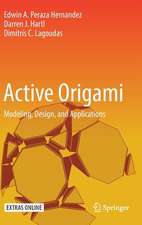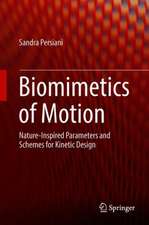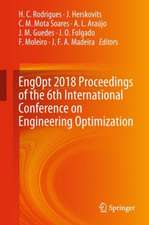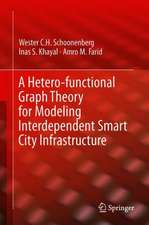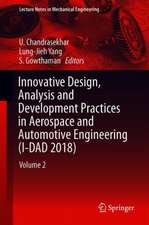A New Perspective of Cultural DNA: KAIST Research Series
Editat de Ji-Hyun Leeen Limba Engleză Hardback – 24 sep 2020
The book offers readers fresh viewpoints on computational design. and helps researchers in academy and practitioners in industry to learn more evolved cultural DNA knowledge which is newly interpreted and conceptually reinforced in areas of mechanical engineering and architectural engineering.
| Toate formatele și edițiile | Preț | Express |
|---|---|---|
| Paperback (1) | 633.35 lei 6-8 săpt. | |
| Springer Nature Singapore – 25 sep 2021 | 633.35 lei 6-8 săpt. | |
| Hardback (1) | 889.12 lei 6-8 săpt. | |
| Springer Nature Singapore – 24 sep 2020 | 889.12 lei 6-8 săpt. |
Preț: 889.12 lei
Preț vechi: 1084.29 lei
-18% Nou
Puncte Express: 1334
Preț estimativ în valută:
170.13€ • 177.63$ • 140.81£
170.13€ • 177.63$ • 140.81£
Carte tipărită la comandă
Livrare economică 04-18 aprilie
Preluare comenzi: 021 569.72.76
Specificații
ISBN-13: 9789811577062
ISBN-10: 9811577064
Ilustrații: VII, 143 p. 83 illus., 66 illus. in color.
Dimensiuni: 155 x 235 mm
Greutate: 0.39 kg
Ediția:1st ed. 2021
Editura: Springer Nature Singapore
Colecția Springer
Seria KAIST Research Series
Locul publicării:Singapore, Singapore
ISBN-10: 9811577064
Ilustrații: VII, 143 p. 83 illus., 66 illus. in color.
Dimensiuni: 155 x 235 mm
Greutate: 0.39 kg
Ediția:1st ed. 2021
Editura: Springer Nature Singapore
Colecția Springer
Seria KAIST Research Series
Locul publicării:Singapore, Singapore
Cuprins
Thoughts on Design Process.- Through Information.- Shape Grammar as a Tool.- Analysis of Cultural Values.
Notă biografică
Ji-Hyun Lee is an Associate Professor at the Graduate School of Culture Technology (GSCT) in Korea Advanced Institute of Science Technology (KAIST). She received her Ph.D. in School of Architecture (Computational Design) at Carnegie Mellon University writing a thesis about integrating housing design and case-based reasoning. Since joining the GSCT at KAIST, her research focus narrowed down to three interdisciplinary areas that are not mutually exclusive: (1) calculation for UX + service design, (2) cultural DNA with morphological analysis, and (3) computational creativity. These explorations result in computer-based frameworks or systems contributing to the enhancement of the calculability using algorithmic and/or heuristic computational methods. In other words, her research focus is on ‘computational culture’ as an extension of computational design.
She served for the Secretary of Computer-Aided Architectural Design Research in Asia (CAADRIA) from 2008 to 2010. Currently, she is the Director of the Information-Based Design (IBD) Research Group, Descartes Lab in KAIST and also serving as the Editorial Board Member for Architecture Research and International Journal of Innovations in Information Technology. She also serves as a Director of Korean Society of Service Design and Innovation (KSSDI), Korean Society of Design Science (KSDS) and HCI Korea. She is a member of Architectural Institute of Korea (AIK), Korea Intelligent Information System Society (KIISS), Society of CAD/ CAM Engineers and SIG-Design Creativity of the Design Society.
She served for the Secretary of Computer-Aided Architectural Design Research in Asia (CAADRIA) from 2008 to 2010. Currently, she is the Director of the Information-Based Design (IBD) Research Group, Descartes Lab in KAIST and also serving as the Editorial Board Member for Architecture Research and International Journal of Innovations in Information Technology. She also serves as a Director of Korean Society of Service Design and Innovation (KSSDI), Korean Society of Design Science (KSDS) and HCI Korea. She is a member of Architectural Institute of Korea (AIK), Korea Intelligent Information System Society (KIISS), Society of CAD/ CAM Engineers and SIG-Design Creativity of the Design Society.
Textul de pe ultima copertă
This book presents selected papers from the 3rd Cultural DNA Workshop. Contributed by prominent computational design experts in the fields of mechanical engineering and architectural design, they mainly focus on the design process; shape grammars as a valuable tool; and the analysis of cultural values.
The book offers readers fresh viewpoints on computational design. and helps researchers in academy and practitioners in industry to learn more evolved cultural DNA knowledge which is newly interpreted and conceptually reinforced in areas of mechanical engineering and architectural engineering.
The book offers readers fresh viewpoints on computational design. and helps researchers in academy and practitioners in industry to learn more evolved cultural DNA knowledge which is newly interpreted and conceptually reinforced in areas of mechanical engineering and architectural engineering.
Caracteristici
Describes fundamental theories and methodologies behind cultural DNA research, supported by real-world examples from architecture and mechanical engineering Brings computational design research from architectural design together with mechanical engineering design groups working on cultural DNA across Asia and America Introduces readers to various tools currently under development that will help academics and practitioners to share ideas at different scales






























